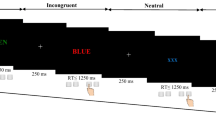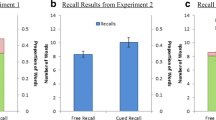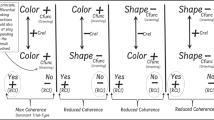Perceptual information is often ambiguous and we have to deal with such ambiguity to ensure optimal behavior; yet, the mechanisms that our brain uses for processing ambiguous stimuli are not well understood. In the current study, we tested whether there were any common markers of neural processing of ambiguity, regardless of its type. To this end, ERPs (event-related potentials) were elicited under similar experimental conditions by either verbal or non-verbal information: ambiguous fi gures vs verbal jokes. It has been suggested that ambiguous graphical information triggers a mismatch confl ict at earlier stages of processing, whereas in case of perception of ambiguous written texts, it takes place at later stages, associated with semantic analysis. Results of our experiment show that perception of both ambiguous figures and verbal jokes was related to semantic reversion, as the amplitude of the negative-going N400 component increased in response to both pictorial and verbal stimuli that were correctly identified as having more than one meaning, in contrast to otherwise similar but unambiguous control stimuli.
Similar content being viewed by others
References
Amsel B. D. and Cree G. S., “Semantic richness, concreteness, and object domain: An electrophysiological study,” Canad. J. Experim. Psychol., 67, 117–129 (2013).
Attardo S. and Raskin V., “Script theory revis(it)ed: Joke similarity and joke representation model,” Humor: Int. J. Humor Res., 4, No. 3–4, 293–348 (1991).
Boring E. G., “A new ambiguous fi gure,” Am. J. Psychol., 42, 444–445 (1930).
Botvinick M. M., Cohen J. D., and Carter C. S., “Confl ict monitoring and anterior cingulate cortex: an update,” Trends Cogn. Sci., 8, No. 12, 539–546 (2004).
Coulson S., Federmeier K. D., Van Petten, C., and Kutas M., “Right hemisphere sensitivity to word-and sentence-level context: evidence from event-related brain potentials,” J. Experim. Psychol.: Learn., Mem., Cognit., 31, No. 1, 129–147 (2005).
Du Y., Zhang Q., Zhang J. X., and Aronoff M., “Does N200 refl ect semantic processing? – An ERP study on Chinese visual word recognition,” PLoS One, 9, No. 3, e90794 (2014).
Elkind D., “Ambiguous pictures for study of perceptual development and learning,” Child Develop., 35, 1391–1396 (1964).
Enriquez-Geppert S., Konrad C., Pantev C., and Huster R. J., “Conflict and inhibition differentially affect the N200/P300 complex in a combined go/nogo and stop-signal task,” Neuroimage, 51, No. 2, 877–887 (2010).
Federmeier K. D. and Kutas M., “Meaning and modality: Infl uences of context, semantic memory organization, and perceptual predictability on picture processing,” J. Experim. Psychol.: Learn., Mem., Cognit., 27, No, 1, 202–224 (2001).
Feng Y. J., Chan Y. C., and Chen H. C., “Specialization of neural mechanisms underlying the three-stage model in humor processing: An ERP study,” J. Neuroling., 32, 59–70 (2014).
Friedrich M. and Friederici A. D., “Early N400 development and later language acquisition,” Psychophysiology, 43, No. 1, 1–12 (2006).
Frings C. and Groh-Bordin C., “Electrophysiological correlates of visual identity negative priming,” Brain Res., 1176, 82–91 (2007).
Gajewski P. D. and Falkenstein M., “Effects of task complexity on ERP components in Go/Nogo tasks,” Int. J. Psychophysiol., 87 No. 3, 273–278 (2013).
Gao C., Hermiller M. S., Voss J. L., and Guo C., “Basic perceptual changes that alter meaning and neural correlates of recognition memory,” Front. Human Neurosci., 9, 49 (2015).
Gibson L., Atchley R. A., Voyer D., et al., “Detection of sarcastic speech: The role of the right hemisphere in ambiguity resolution,” Laterality: Asym. Body, Brain Cognit., 21, No. 4–6, 549–567 (2015).
Gotts S. J., Chow C. C., and Martin A., “Repetition priming and repetition suppression: Multiple mechanisms in need of testing,” Cogn. Neurosci., 3, No. 3–4, 250–259 (2012).
Haro J., Demestre J., Boada R., and Ferré P., “ERP and behavioral effects of semantic ambiguity in a lexical decision task,” J. Neuroling., 44, 190–202 (2017).
Hoffman P., Lambon Ralph M. A., and Rogers T. T., “Semantic diversity: A measure of contextual variation in word meaning based on latent semantic analysis,” Behav. Res. Methods, 45, 718–730 (2013).
Huster R. J., Enriquez-Geppert S., Lavallee C. F., et al., “Electroencephalography of response inhibition tasks: functional networks and cognitive contributions,” Int. J. Psychophysiol., 87, No. 3, 217–233 (2013).
Iannaccone R., Hauser T. U., Staempfl i P., et al., “Conflict monitoring and error processing: new insights from simultaneous EEG–fMRI,” Neuroimage, 105, 395–407 (2015).
Intaité M., Koivisto M., and Castelo-Branco M., “Event-related potential responses to perceptual reversals are modulated by working memory load,” Neuropsychologia, 56, 428–438 (2014).
Intaite M., Koivisto M., and Revonsuo A., “Perceptual reversals of Necker stimuli during intermittent presentation with limited attentional resources,” Psychophysiology, 50, 82–96 (2013).
Kopp B., Rist F., and Mattler U. W. E., “N200 in the flanker task as a neurobehavioral tool for investigating executive control,” Psychophysiology, 33, No. 3, 282–294 (1996).
Kornmeier J. and Bach M., “EEG correlates of perceptual reversals in Boring’s ambiguous old/young woman stimulus,” Perception, 43, 950–962 (2014).
Kirsten M., Tiemann S., Seibold V. C., et al., “When the polar bear encounters many polar bears: event-related potential context effects evoked by uniqueness failure,” Lang., Cognit. Neurosci., 29, No. 9, 1147–1162 (2014).
Kubota J. T. and Ito T. A., “Multiple cues in social perception: The time course of processing race and facial expression,” J. Experim. Soc. Psychol., 43, No. 5, 738–752 (2007).
Kutas M. and Federmeier K. D., “Electrophysiology reveals semantic memory use in language comprehension,” Trends Cogn. Sci., 4, No 12. 463–470 (2000).
Kutas M. and Hillyard S. A., “Reading senseless sentences: Brain potentials reflect semantic incongruity,” Science, 207, No. 4427, 203–205 (1980).
Lau E. F., Holcomb P. J., and Kuperberg G. R., “Dissociating N400 effects of prediction from association in single-word contexts,” J. Cogn. Neurosci., 25, No. 3, 484–502 (2013).
Lei W., Zheng J., and Lu Q., “Event-related potentials and the decision making under risk and ambiguity,” IEEE 2014 Int. Conf. on Multisensor Fusion and Information Integration for Intelligent Systems (MFI 2014) (2014).
Martin R. A., The Psychology of Humor: An Integrative Approach, Academic Press (2010).
Mayerhofer B., Neuro-Cognitive Processing of Garden Path Jokes: Theoretical Concepts and Empirical Correlates (2014).
Mayerhofer B. and Schacht A., “From incoherence to mirth: neuro-cognitive processing of garden-path jokes,” Front. Psychol., 6, 550 (2015).
Morozova V. A., Yevtushenko S. K., and Morozova T. M., “Multifocal event-related evoked potentials in early diagnostics of сognitive disintegration: clinical and neurophysiologic interpretation,” Mezhdunar. Nevrol. Zh., 3, 26–41 (2012).
Nieuwenhuis S., Yeung N., Van Den Wildenberg W., and Ridderinkhof K. R., “Electrophysiological correlates of anterior cingulate function in a go/no-go task: effects of response confl ict and trial type frequency,” Cogn., Affect. Behav. Neurosci., 3, No. 1, 17–26 (2003).
Ortells J. J., Kiefer M., Castillo A., et al., “The semantic origin of unconscious priming: Behavioral and event-related potential evidence during category congruency priming from strongly and weakly related masked words,” Cognition, 146, 143–157 (2015).
Özyürek A., “Hearing and seeing meaning in speech and gesture: Insights from brain and behaviour,” in: Philos. Trans. of the Royal Society of London, Ser. B, Biol. Sci. (2014), Vol. 369(1651), p. 20130296.
Rabovsky M., Sommer W., and AbdelRahman R. A., “The time course of semantic richness effects in visual word recognition,” Front. Human Neurosci., 6, 11 (2012).
Renn R. P. and Cote K. A., “Performance monitoring following total sleep deprivation: effects of task type and error rate,” Int. J. Psychophysiol., 88, No. 1, 64–73 (2013).
Sanguinetti J. L., Allen J. J., and Peterson M. A., “The ground side of an object: perceived as shapeless yet processed for semantics,” Psychol. Sci., 25, No. 1, 256–264 (2014).
Siemann J., Herrmann M., and Galashan D., “fMRI-constrained source analysis reveals early top-down modulations of interference processing using a fl anker task,” Neuroimage, 136, 45–56 (2016).
Soldan A., Habeck C., Gazes Y., and Stern Y., “Neural mechanisms of repetition priming of familiar and globally unfamiliar visual objects,” Brain Res., 1343, 122–134 (2010).
Van Veen V. and Carter C. S., “The anterior cingulate as a confl ict monitor: fMRI and ERP studies,” Physiol. & Behav., 77, No. 4, 477–482 (2002).
Vergara-Martínez M., Comesaña M., and Perea M., “The ERP signature of the contextual diversity effect in visual word recognition,” Cogn., Affect., Behav. Neurosci., 17, No. 3, 461–474 (2017).
Vo M., Lauer T., and Cornelissen T., “Semantic integration without semantics? Meaningless synthesized scenes elicit N400 responses to semantically inconsistent objects,” Perception, 45, 177–178 (2016).
Wieser S. and Wieser H. G., “Event-related brain potentials in memory: correlates of episodic, semantic and implicit memory,” Clin. Neurophysiol., 114, No. 6, 1144–1152 (2003).
Wyer R. S. and Collins J. E., “A theory of humor elicitation,” Psychol. Rev., 99, No. 4, 663–688 (1992).
Author information
Authors and Affiliations
Corresponding author
Additional information
Published in Zhurnal Vysshei Nervnoi Deyatel’nosti imeni I. P. Pavlova, Vol. 69, No. 2, pp. 175–186,March–April, 2019.
Rights and permissions
About this article
Cite this article
Filippova, M.G., Shcherbakova, O.V. & Shtyrov, Y.Y. It is Not What You Think it is: Erp Correlates of Verbal And Non-Verbal Ambiguity Processing. Neurosci Behav Physi 50, 306–314 (2020). https://doi.org/10.1007/s11055-020-00902-5
Received:
Revised:
Accepted:
Published:
Issue Date:
DOI: https://doi.org/10.1007/s11055-020-00902-5




